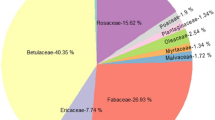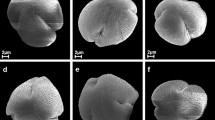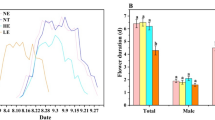Abstract
THE Gnetales are considered to be the most highly evolved order among the gymnosperms. Tho fossil record of the order is surprisingly poor, and has been reviewed by Wilson1. Some palynologists have, however, reported the occurrence of fossil pollen grains having close resemblance to gnetalean pollen. While analysing some samples from Dharamsala beds (Lower Miocene to Oligocene) of Kangra District, Punjab, we came across some pollen grains which showed a gnetalean affinity.
This is a preview of subscription content, access via your institution
Access options
Subscribe to this journal
Receive 51 print issues and online access
$199.00 per year
only $3.90 per issue
Buy this article
- Purchase on SpringerLink
- Instant access to full article PDF
Prices may be subject to local taxes which are calculated during checkout
Similar content being viewed by others
References
Wilson, L. R., Oklahoma Geol. Notes, 19, No. 2, 35 (1959).
Scott, R. A., Micropaleontology, 6, No. 3, 271 (1960).
Wodehouse, R. P., Torrey Club. Bull., 60, (1933).
Wodehouse, R. P., Mem. Conn. Acad., 9, (1935).
Bolkhovitina, N. A., cited in Catalog of Fossil Spores and Pollen by Kremp, 8, 90 (1953).
Kuyl, O. S., Muller, J., and Waterbolk, H. T., Geologie en Mijnbouw, N.S. 17, No. 3, 49 (1955).
Bharadwaj, D. C., The Palaeobotanist, 9, NoS. 1 and 2, 68 (1960).
Wodehouse, R. P., Pollen Grains (McGraw-Hill Book Co., New York, 1935).
Cookson, I. C., Nature, 177, 47 (1956).
Author information
Authors and Affiliations
Rights and permissions
About this article
Cite this article
GHOSH, A., BANERJI, D. & SRIVASTAVA, S. Ephedra-type Pollen Grains in the Dharamsala (Tertiary) Formations, Punjab, India. Nature 198, 408 (1963). https://doi.org/10.1038/198408a0
Issue date:
DOI: https://doi.org/10.1038/198408a0



